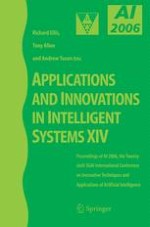2007 | Buch
Applications and Innovations in Intelligent Systems XIV
Proceedings of AI-2006, the Twenty-sixth SGAI International Conference on Innovative Techniques and Applications of Artificial Intelligence
herausgegeben von: Richard Ellis, BSc, MSc, Dr Tony Allen, PhD, Dr Andrew Tuson, MA, MSc, PhD, MBCS
Verlag: Springer London
